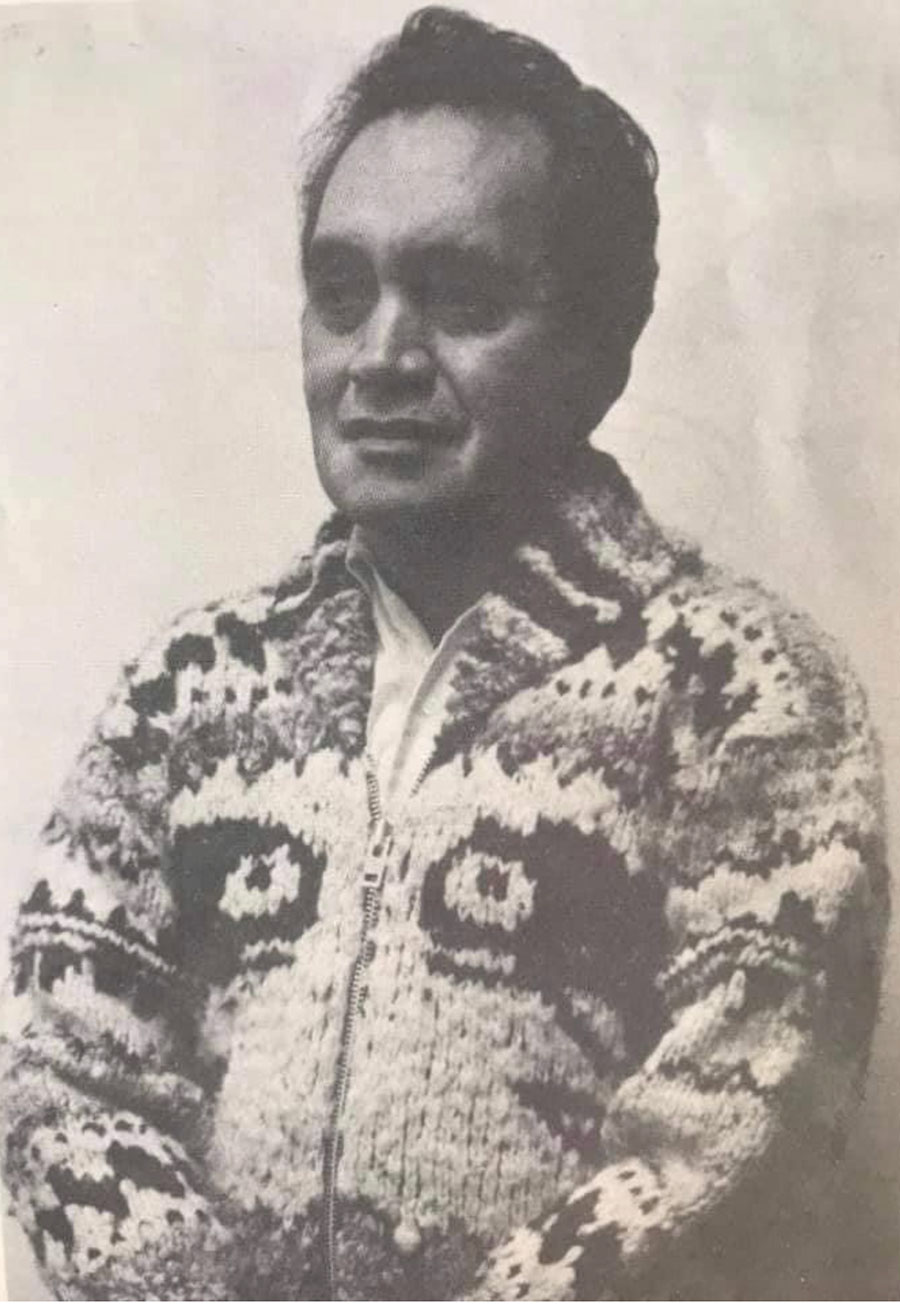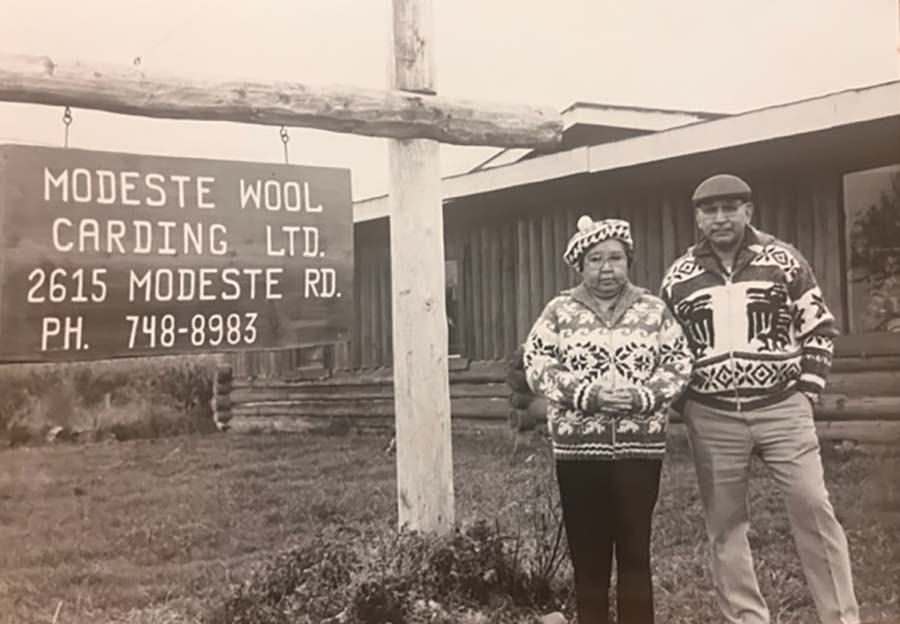Indigenous Filmmaker Mary Galloway Explores the Story of the Cowichan Sweater and the Knitters Who Carry On Its Legacy

Mary Galloway sits with Maureen Tommy (right) and Dora Wilson (left), second and third generation Cowichan knitters who helped create a replica of her grandfather's Cowichan sweater. Photo: Courtesy of Mary Galloway
Filmmaker Mary Galloway has a feeling there was something spiritual at play during the making of her latest documentary, The Cowichan Sweater: Our Knitted Legacy.
“I don’t know if it was the ancestors looking out for us or what, but it just fell into place exactly as it was meant to be,” Galloway, an acclaimed director of Cowichan and settler descent, said of the film, which premières Friday.
The documentary, which was shot in Cowichan and Saanich Territory on Vancouver Island, tells the story of the Cowichan sweater and the knitters in the region who serve as the keepers of its legacy.
Up until the 1880s, the Coast Salish people had made clothing and blankets by weaving dog and goat hair. It’s believed that around that time a Scottish expat named Jeremina Colvin taught the Indigenous women how to knit using sheep’s wool after settling in Cowichan Bay and forming a close bond with her neighbours. The sweaters arrived soon after, boasting a material that was both warm and waterproof due to an oil called lanolin from the sheep’s wool that remains in the fabric.
Galloway was perhaps one of the early pieces to fall into place for the documentary. In fact, it wasn’t until after she was selected to helm the film that she discovered a personal connection with the subject matter, a treasured photograph of her grandfather, the late Chief Dennis Alphonse, wearing a Cowichan sweater.
Until that point, she had paid little mind to his sweater, which was adorned with two killer whales, one of the many animals often depicted on the traditional garment.
“It’s such a beautiful photo,” she says. “It’s one of the main pictures that I’ve looked at all my life of him.”

The discovery would add another narrative layer to the film, with Galloway setting out to have a replica of the sweater made in his honour.
“I just always felt like there was a piece missing with my grandpa, because I really wish I got to know him more,” she says of Alphonse, who served as chief and council of the Cowichan Indian band for more than 40 years, and passed away in 2004 when Galloway was only 13. “It was an opportunity to bring me a little bit closer to him and to have something that reminds me of him.”
Today, Cowichan knitters still make the garments entirely by hand — which can take upwards of two days to complete — from washing, spinning and dying the wool to the knitting itself.
Throughout the film, Galloway sits down for intimate interviews with the elders who carry on the tradition, many of whom once relied upon the labour intensive craft to feed their families.
“The producer and I have often talked about how we feel like we are caregivers for the story,” she says. “We’re not owners of the story, we are given the opportunity and the blessing to be able to tell it, but it’s not our story, it’s the knitter’s story.”
A crucial part of that story is the economic role the sweaters once played for Indigenous communities on the island, beginning in the 1920s when Indigenous crafts were seen by settlers as valuable collectables. During that time, Indian agents — the federal administrators of Indigenous policy — sent the sweaters to fairs and exhibitions, while knitters independently sold their garments to merchants in downtown Duncan, Victoria and Vancouver.
Among those early entrepreneurs was Sarah Modeste, who opened her own mill in Duncan to supply local knitters with ready-to-knit wool.

In the doc, Modeste recalls the first time she ever sold one of her own Cowichan sweaters, no doubt an early precursor to the business she would later run.
But contained in her story is also the subject of appropriation of the art that came along with the sweater’s popularity, which took off throughout the 1970s and ’80s when the garment emerged as a fashion staple. During that period, celebrities, politicians and world dignitaries often received the sweaters upon visits to Canada. President Harry Truman and Queen Elizabeth II were among those presented with the handmade garments, while former prime minister Pierre Trudeau sported one for a 1980 Christmas card photo with his three sons.

According to a pair of farmers featured in the doc who once supplied Modeste with sheep wool, she was forced to close her mill after a Japanese company trademarked genuine Cowichan sweaters and began mass-producing knockoffs of the garment.
While Modeste steered clear of that painful memory during her interview, Galloway says meeting the entrepreneur and hearing how concerned she was about the survival of the practice drove home the importance of the story she set out to tell.
“She is one of the matriarchs of knitting,” she explains. “I think just hearing how precious it is to her just really ingrained in me the importance of keeping it alive.”
The Cowichan Indian band have since registered a trademark for “Genuine Cowichan,” resulting in a number of legal battles with large companies, including fashion giant Ralph Lauren. The trademark ensures the Cowichan name is only used for products that “have been hand-knit in one piece in accordance with traditional tribal methods” and that each certified garment is labeled “Genuine Cowichan Approved.”
The craft’s future is in large part tied to its economic viability. Even when sales for the sweaters were booming, knitters were underpaid for their work. Today, that problem persists, with knitters making around a dollar an hour for their labour.
“The youth right now have a really hard time getting excited abut learning something [that] basically equates to slave labour,” Galloway explains. “Hopefully this doc will help raise the respect for the knitters and people can offer the prices that the knitting is worth. You are getting a work of art that’s been refined and perfected and takes dozens of hours to make.”
As for the companies producing knockoffs of the sweaters and those who buy them, the message, delivered by Cowichan and Haida filmmaker Rosie Johnnie-Mills in the film, is loud and clear: Both are “contributing to the erasure and committing to the further genocide of Salish people.”
While Galloway says including that piece of the story was important, she didn’t want it to distract from her main objective.
“We want to make this a love story for Cowichan sweaters,” she says of the film. “We don’t want to keep exposing the traumas within our community. So it was important to hit on it for a moment, but not to linger on it. Hopefully people will pay attention to that and take it to heart.”
Galloway adds that buying authentic is “a great way people can participate in reconciliation between the nation and the settler.”
Meanwhile, Galloway’s personal journey revealed the intangible value each of the sweaters hold.
With three generations of Cowichan knitters contributing to the garment, it was Galloway who completed its final stitches, which is called the casting off.
“Now I have this wonderful sweater that every time I put on, I’ll be reminded of him and the great things he’s done,” she says, recalling a particular moment where one of the knitters calls him “the greatest chief ever.”
“That line just stays with me. As a director and a filmmaker, I’m oftentimes leading a team of people and I feel like I am a little bit of him.”
As for how often she’s wearing the replica, Galloway admits she’s still being “very precious with it.”
“But as soon as it becomes like -20 in Winnipeg, I know I’m gonna be wearing it every single day.”
The Cowichan Sweater: Our Knitted Legacy premières Oct. 6 on CBC Gem and CBC TV at 8:00 p.m., the following day in B.C. and Alberta